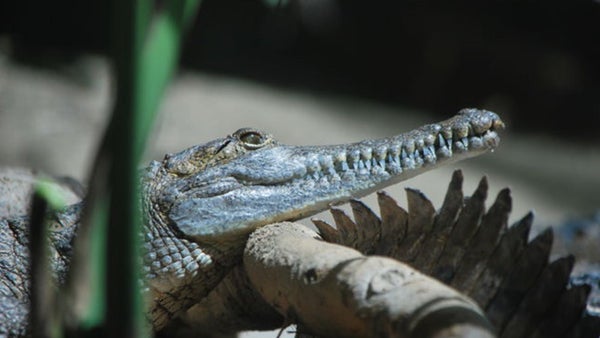This article was published in Scientific American’s former blog network and reflects the views of the author, not necessarily those of Scientific American
Let’s say you find yourself being pursued by a large, semi-aquatic reptile. I won’t ask how this happened. That’s your business. But as you’re scurrying away, you may want to take a moment to notice what variety of saurian is following you. If they’re moving at a quick-paced walk, it might be an alligator. If they’re bounding and jumping, that’s a crocodile. Something to think about as you slowly realize that either method allows the crocodylians to attain the same speed.
Zoologists have long known that some crocodiles can gallop and bound. You may have even seen freshwater crocodiles doing so on nature documentaries, pushing off with their front legs and swinging their rear limbs forward for a big spring. But, as biomechanics expert John Hutchinson and colleagues have revealed, at least seven species of crocodile are capable of what can honestly be called a “gallop.” Alligators, by contrast, can move just as fast, but they can’t, or don’t, bound in the same frighteningly floppy way.
The reptiles who’ve made this latest contribution to our herpetological knowledge all dwell at the St. Augustine Alligator Farm and Zoological Park, a place that’s helped researchers examine everything from which species of crocodylian “death roll” to whether alligators use tools. This time around, the researchers examined 42 individual animals representing 15 species. After being captured in the enclosure, having vital stats taken, and marked with white poster paint at critical points, the animals were given a rest. Then came the tricky part.
On supporting science journalism
If you're enjoying this article, consider supporting our award-winning journalism by subscribing. By purchasing a subscription you are helping to ensure the future of impactful stories about the discoveries and ideas shaping our world today.
Getting a crocodile to run is no easy task. The researchers set up a roughly 16-foot-long, 4-foot-wide runway with cameras arrayed along its length. “Animals were encouraged to move across the runway by simple release, auditory/visual cues, gentle prodding, and/or placement of refugia (bushes/water) at the end of the runway,” the study states, indicating that sometimes a methods section of a peer-reviewed paper really can leave you wanting to know more.
The crocodiles really did give it their all. In fact, five of the crocodile species that bounded over the croc walk had never been recorded doing so before. This isn’t to say that galloping or bounding was the only way they moved. The larger the crocodiles were, the less likely they were to gallop. Remember the scene of the 40-foot bounding Nile crocodile in the movie Primeval? I hate to tell you, if you didn’t know already, but that was more fiction than reality.
The alligators moved in a different way. No member of the alligator family bounded or galloped, despite being able to move just as fast at a trot. The question is why. There seems to be no obvious physical or physiological reason for the difference. And, as the authors note, some of the alligator-lineage individuals selected for the study had to be left out because alligators, in general, were more likely to hiss, struggle, and object to the trials. Perhaps the conditions, or motivation, were not right for the alligators, or that there is some ancient behavioral reason that alligators are more likely to fight while crocodiles are more likely to run.
Discerning the great galloping difference between alligators and crocodiles raises additional questions. If prehistoric crocodile relatives were capable of galloping and bounding motions, but modern alligators can’t, what could explain the disparity? Perhaps the alligator lineage lost the ability. Maybe the tests run so far just haven’t recorded the behavior. Or maybe the ability to bound and gallop was lost during the evolution of modern, semi-aquatic crocodylians and evolved anew in the modern crocodile line. There’s also the question of why crocodiles gallop at all, especially when trotting – as alligators do – is actually a little faster. There’s plenty more to investigate and uncover about the way crocs move, and I can only hope that scientists make it snappy.
